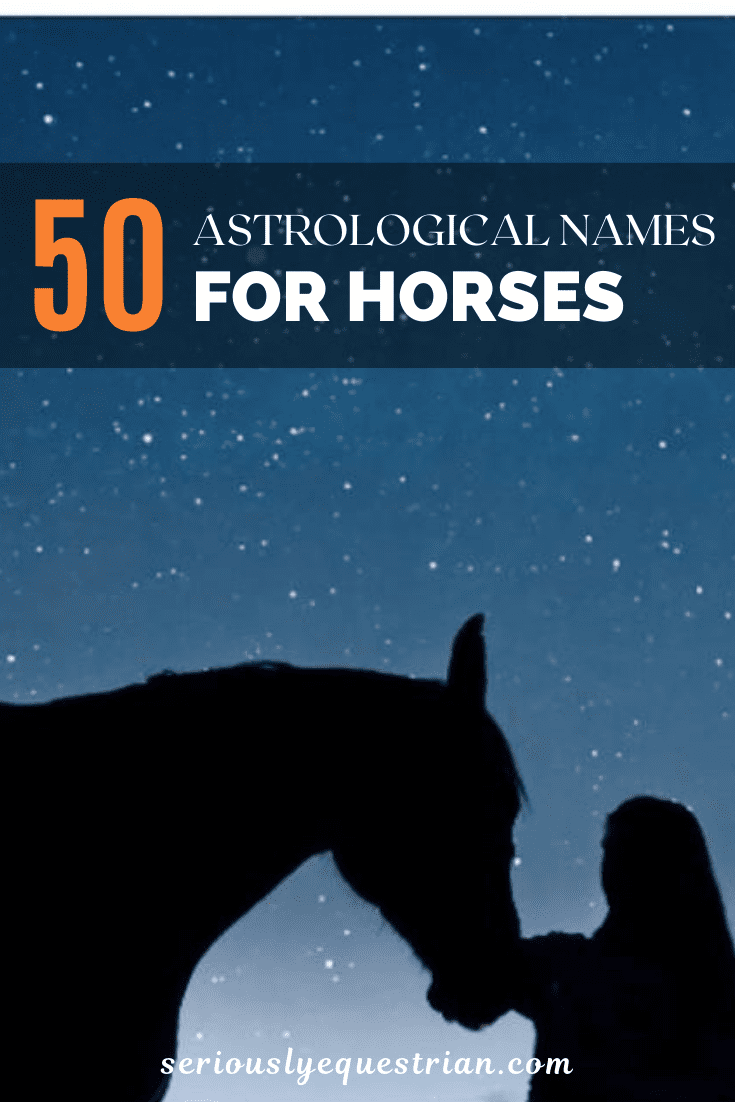If you are looking for a Horse name then why not simply tilt your head upwards and look at the sky during night. The cosmos are filled with planets, constellations, and stars, many of which have truly beautiful names. These names are often derived from Greek god and Goddesses and are also some of the most popular names for newly born babies.
Many of the names are classic names that are consistently popular whereas others are quirky, unusual, or just downright strange Naming a horse should be a fun experience so make sure you enjoy the process.
Here are some of our favourite astrological names for horses:
Astrology Names for Stallions & Geldings
- Aten: are a dynamical group of asteroids whose orbits bring them into proximity with Earth
- Apollo: Greek god of the sun and light, and the name of a famous NASA space programme. Apollo has been consistently popular as a name for horses. The most well known Apollo was perhaps a racehorse who was best known for winning the 1882 Kentucky Derby.
- Arche: A moon that orbits Jupiter and a great name for a horse. The spelling Archie is a more popular variation of the name.
- Atlas: Atlas is an inner moon of Saturn, orbiting around the outer edge of Saturn’s A Ring. ATLAS was also the name of a series of Shuttle flights, was an important part of the long-term, coordinated research that made up NASA’s Mission to Planet Earth
- Caelum: is a faint constellation in the southern sky, introduced in the 1750s by Nicolas Louis de Lacaille
- Comet: are snowballs made up of frozen gas, rock, and dust that orbit the Sun. A good name for a fast moving horse
- Cosmo: meaning universe and short for cosmology; cosmonaut; cosmography
- Deimos:is the smaller and outermost of the two natural satellites of Mars, the other being Phobos
- Draco: Draco is also the origin point for the annual Draconids meteor shower. The name is best known from the Harry Potter series in which Draco Malfoy is Harry Potters Nemesis.
- Halo: spherical population of stars and globular clusters thought to surround most disk galaxies and the cD class of elliptical galaxies. It could also be used as a name for a mare.
- Hercules: Hercules is a constellation named after Hercules, the Roman mythological hero. A good name for a particularly strong horse.
- Jupiter: is the fifth planet from the Sun and the largest planet of the Solar System. It is the oldest planet of the Solar System thus it was the first to take shape out of the remains of the solar nebula.
- Kale:is a retrograde irregular satellite of Jupiter. It was discovered in 2001
- Mars: the red planet, named after the Roman god of war
- Mercury: smallest of the eight planets in our solar system. . It is named after the Greek god Hermes, translated into Latin Mercurius Mercury, god of commerce.
- Neptune: Named after the Roman god of the sea, Neptune is the eighth and farthest-known planet from the Sun. In the Solar System, it is the fourth-largest planet by diameter, the third-most-massive planet, and the densest giant planet.
- Orion:is a prominent constellation located on the celestial equator and visible throughout the world. It is one of the most conspicuous and recognizable constellations in the night sky. It is named after Orion, a hunter in Greek mythology. It is also a great name for a bright horse.
- Pallas: Pallas is the second asteroid to have been discovered, after 1 Ceres. It is the third-largest asteroid in the Solar System by both volume and mass
- Perseus: Perseus is a constellation in the northern sky. The constellation is named for the Greek mythological hero and demigod Perseus
- Phoenix: Phoenix is a minor constellation in the southern sky. Named after the mythical phoenix
- Pluto: originally considered the ninth planet of our solar system, Pluto has since been classified as a dwarf planet. It was the first and the largest Kuiper belt object to be discovered
- Proteus: is the sixth of Neptune’s known satellites and the second largest
- Rigel: is a blue-white super giant star at 863 light-years from Earth in the constellation of Orion
- Thule: A large asteroid discovered in 1888
- Triton: is the largest natural satellite of the planet Neptune, and the first Neptunian moon to be discovered. … It is the only large moon in the Solar System with a retrograde orbit, an orbit in the direction opposite to its planet’s rotation
Astrology Names for a Mare
- Ariel: moon of Uranus, made of ice and rocky material
- Amalthea: is a moon of Jupiter that has surface of large craters and mountains
- Astrid: Astrid-1 and Astrid-2 were two microsatellites designed and developed by Swedish Space Corporation on behalf of the Swedish National Space Board. It is a popular name for baby girls but could also be a good name for your mare.
- Aurora: is the Roman goddess of the sunrise and a Aurora Space Station concept that was announced in 2018.
- Belinda: ninth moon of Uranus, part of the Portia group of satellites
- Bellatrix: star in the Orion constellation
- Bianca: one of 13 inner moons of Uranus
- Carina: constellation containing Canopus, the second-brightest star in the sky
- Cassiopeia: northern constellation with a distinctive W shape
- Celeste: from celestial, meaning heavenly
- Ceres: dwarf planet in the inner solar system, may contain pure water ice
- Cordelia: inner moon of Uranus
- Cressida: fourth-largest moon of Uranus
- Elara: moon of Jupiter, named after one of Zeus’s lovers
- Fay: stars, attendants of the moon in the night sky in poetry
- Galatea: inner satellite of Neptune
- Galaxy: is a huge collection of gas, dust, and billions of stars and their solar systems. A galaxy is held together by gravity. Earths galaxy is known as the Milky Way
- Gemini: a constellation of the zodiac, Latin for twins
- Halley: comet visible to the human eye every 75 yearss. Halley is the only known short-period comet that is regularly visible to the naked eye from Earth
- Helene: moon of Saturn, discovered in 1980
- Juliet: moon of Uranus, belongs to Portia group of satellites
- Larissa: fifth moon of Neptune
- Luna: Latin for moon
- Lyra: Lyra is a northern summer constellation, which is highest in the midnight sky in the months around June
- Maia: a blue-giant star in the Taurus constellation
- Miranda: smallest of the major moons of Uranus
- Norma: small constellation in the southern hemisphere
- Nova: nuclear explosion in a white dwarf star
- Ophelia: second moon of Uranus, a shepherd satellite with Cordelia. A name made famous by Shakespeare.
- Pandora: heavily-cratered moon of Saturn
- Phoebe: moon of Saturn, and the first satellite discovered
- Portia: moon of Uranus, heads Portia group of satellites
- Rhea: one of Saturn’s moons
- Rosalind: moon of Uranus, discovered in 1986
- Stella: Latin for star, variations Estelle, Estella
- Thebe: red-coloured inner satellite of Jupiter
- Titania: largest of Uranus’ moons, queen of the fairies in Shakespeare’s A Midsummer Night’s Dream
- Vega: one of the brightest stars in the sky, in the Lyra constellation
- Venus: Venus is the brightest planet in our solar system and also the hottest. A good name for a fiery mare?
Astrology Unisex Horse Names
- Andromeda: large constellation, Andromedids meteor shower
- Aries: constellation of the zodiac, Latin for ram
- Callisto: moon of Jupiter, nymph transformed into a bear and set amongst the stars in Greek myth
- Charon: largest moon of Pluto, which was discovered in 1978
- Dione: moon of Saturn with a surface of ice cliffs
- Europa: is the smallest of the four Galilean moons orbiting Jupiter, and the sixth-closest to the planet of all the 79 known moons of Jupiter
- Janus: is an inner satellite of Saturn. It is also known as Saturn X. It is named after the mythological Janus.
- Libra: is a constellation of the zodiac and is located in the Southern celestial hemisphere. Its name is Latin for weighing scales
- Nysa: a large and very bright main-belt asteroid, and the brightest member of the Nysian asteroid family
- Oberon: moon of Uranus, consists of ice and rock
- Polaris: bright star above the North Pole, also called North Star, or Pole Star
- Sol: Latin name for the sun
- Sirius: brightest star in the sky.
- Urania: daughter of Zeus, Greek muse in charge of astronomy
- Vega: brightest star in the Lyra constellation
- Zeke: shooting star in Arabic














